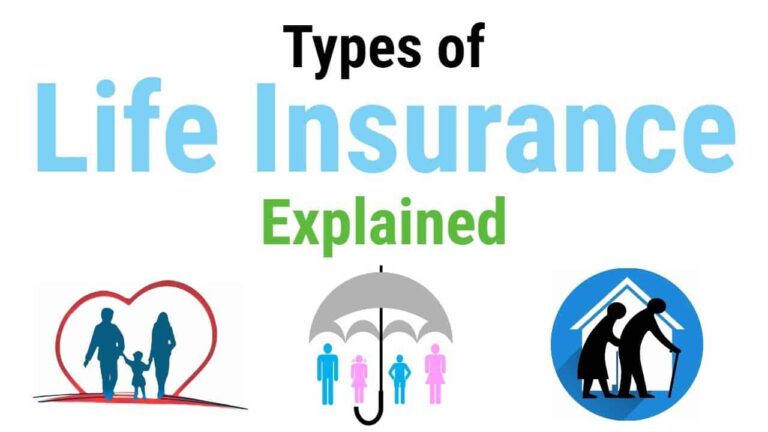Types of life insurance: term life, whole life, universal life is a vital financial tool that provides a safety net for your loved ones in the event of your untimely demise. It offers financial protection and peace of mind by ensuring that your beneficiaries receive a sum of money upon your death. However, the world of life insurance is diverse, with various types of policies designed to meet different needs and goals. In this comprehensive guide, we will delve into three primary types of life insurance: term life, whole life, and universal life. By understanding the nuances of each, you can make an informed decision that aligns with your unique financial objectives and circumstances.
Term Life Insurance
Term life insurance is the most straightforward and affordable type of life insurance. It provides coverage for a specified term, typically ranging from 10 to 30 years. Here are some key characteristics and advantages of term life insurance:
- Affordability: Term life insurance is often the most budget-friendly option. Since it offers pure death benefit coverage without cash value accumulation, the premiums are lower compared to other types of policies.
- Temporary Coverage: It is designed to cover specific financial obligations or needs over a set period. For example, you might choose a 20-year term policy to ensure your children’s financial security until they become financially independent.
- Customizable: You can tailor the coverage amount and term to match your needs. This flexibility allows you to align your policy with short-term financial goals.
- No Cash Value: Unlike whole life and universal life policies, term life insurance does not build cash value. Once the term ends, the coverage ceases unless you renew it or convert it to a permanent policy.
- Conversion Options: Some term policies offer conversion options, allowing you to convert your term policy into a permanent one without a medical examination, providing more long-term security.
Whole Life Insurance
Whole life insurance is a form of permanent life insurance that provides lifelong coverage and includes an investment component. Here are some essential features and advantages of whole life insurance:
- Lifetime Coverage: Whole life insurance provides coverage for your entire life, as long as premiums are paid. This guarantees a death benefit payout to your beneficiaries.
- Cash Value Accumulation: A portion of your premium payments is allocated to a cash value account, which grows over time. This cash value can be borrowed against or used for various financial purposes.
- Fixed Premiums: Premiums for whole life insurance are typically fixed, making it easier to budget for the long term.
- Tax Benefits: The cash value growth in a whole life policy is tax-deferred, meaning you don’t pay taxes on the gains until you withdraw them.
- Conservative Investment: Whole life policies typically invest in conservative assets like bonds and provide a guaranteed minimum interest rate.
- Asset Protection: In some cases, the cash value of a whole life policy may be protected from creditors, providing an additional layer of financial security.
Universal Life Insurance
Universal life insurance is another form of permanent life insurance that offers flexibility in premium payments and death benefit amounts. It combines life insurance with an investment component. Here are the main characteristics and benefits of universal life insurance:
- Flexible Premiums: Universal life policies allow you to adjust your premium payments within certain limits. This flexibility can be helpful during times of financial uncertainty or changing income levels.
- Adjustable Death Benefit: You can also modify the death benefit amount, increasing or decreasing it to better suit your evolving needs.
- Cash Value Growth: Like whole life insurance, universal life policies have a cash value component that can accumulate over time. You can invest the cash value in a variety of investment options, including stocks, bonds, or money market funds.
- Tax Advantages: The cash value growth is tax-deferred, providing tax benefits. Additionally, you can access the cash value through tax-advantaged loans and withdrawals.
- Interest Rate Variability: Universal life policies often offer the potential for higher returns on your cash value investments compared to whole life policies. However, this also means you bear more investment risk.
- Cost of Insurance: The cost of insurance in a universal life policy can increase over time, especially if the cash value growth does not offset the rising costs. It’s essential to monitor and manage your policy to prevent it from lapsing prematurely.
Conclusion
In summary, life insurance plays a crucial role in financial planning, ensuring that your loved ones are financially protected in case of your death. The choice between term life, whole life, and universal life insurance depends on your individual needs, financial goals, and risk tolerance.
It’s crucial to consult with a qualified insurance advisor or financial planner to assess your unique situation and choose the life insurance type that best aligns with your goals. Whichever type you select, life insurance can offer peace of mind, knowing that your loved ones will be financially secure even after you’re gone.







